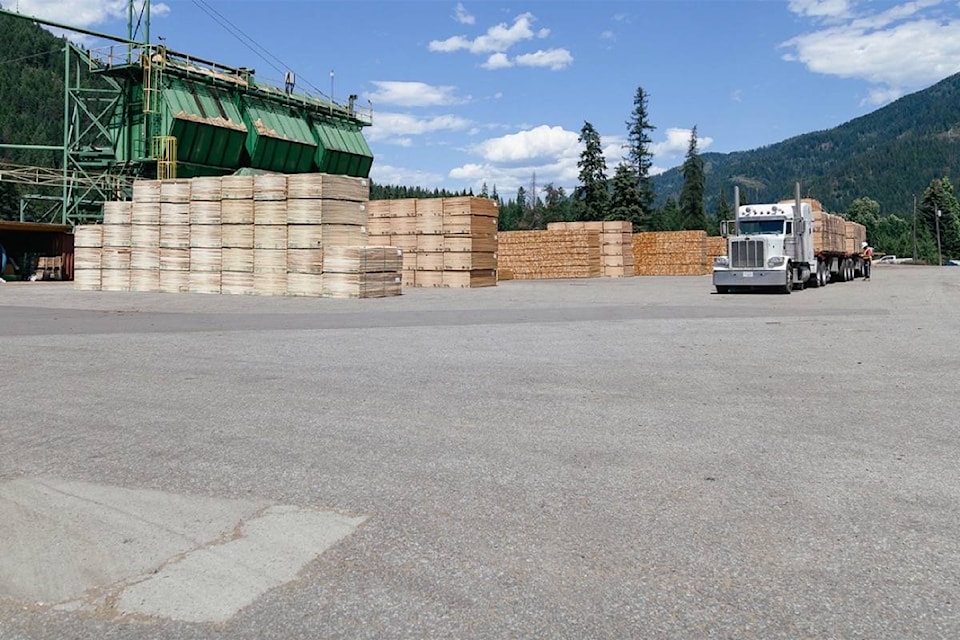A family-run mill, and key West Kootenay employer, has rode out many storms in 60+ years of operations in Fruitvale.
So this latest downturn in the lumber industry across British Columbia - due to poor market conditions, disastrous wildfires, and ongoing insect infestations - is one more challenge that ATCO Wood Products is prepared to face through progressive planning.
“At ATCO Wood Products, we are not immune to these phenomenons,” Chief Executive Officer Scott Weatherford told the Trail Times. “We are evaluating market conditions day by day, and charting a new path weekly to weather these challenges.”
As a producer of softwood veneer for the plywood industry, ATCO supplies a small, niche product to a market that is also presently in an economic downswing.
Much of the company’s timber comes from Crown land harvesting operations. So the increased log cost cited by other B.C. mills as a reason for their cutbacks, has affected ATCO’s bottom line as well.
That means the Fruitvale business has been forced to run fewer days a week, on occasion.
“Prices and demand for our product are down,” Weatherford said.
“And we have been forced to curtail operations intermittently, depending on market conditions each week (such as) running three or four days per week instead of the normal five, some weeks.”
On Monday, Canfor Corp., announced it would curtail operations at all but one of its mills for two to six weeks due to market conditions. The company also closed its mill in Vavenby (North Thompson River) last week, eliminating 172 jobs.
On Tuesday, Norbord Inc. said operations would be suspended at its 100 Mile House mill indefinitely, impacting 160 employees.
Last month, Interfor, which operates sawmills in Grand Forks and Castlegar, said it was reducing production and shutting the mills down for several unspecified days in June.
“We’re also keeping a watchful eye on the weather, and hoping that the forecasts for a third and terrible forest fire season do not come to pass,” Weatherford said.
“Wood products markets are cyclical, and at over 60-years old, our company has weathered many of these cycles.
“While we are working through challenging times, we’re also using the opportunity to innovate, learn, and reinvest to make us stronger to weather future cycles.”
With no foreseeable end to the impact of beetle infestations and wildfire, the immediate solution lies in stringent industry practices.
By implementing forest management and harvesting plans, ATCO’s forestry team is now focused on managing beetle outbreaks in Douglas Fir, as they did with Mountain Pine Beetle in years past.
“We’ve also had some luck in our region during the last two years, as the forest fire season has not affected our company to the same degree than many other forest companies in central and northern B.C have been affected,” said Weatherford.
“However, we have a very resourceful team, a very high quality product, and have been reinvesting in our Fruitvale operations for many years to improve our operating efficiency,” he added.
“Together, this has helped us mitigate a small portion, but not all, of the challenging market conditions, and helped us avoid full curtailments.”
Challenging market conditions boil down to lack luster demand for wood products in North America, which causes prices to drop.
Weatherford says lumber prices have fallen over 50 per cent from spring 2018 highs, making it difficult for mills to find customers for all of their production, which leads to operational cutbacks.
“In addition, imports of wood products from overseas (Asia, South America, and Europe) are further adding to the supply/demand imbalance in the marketplace,” he explained.
“Exacerbating the tough market conditions for producers in B.C., are very high and increasing log costs. This is due to the lag in the formula that is used to calculate stumpage payments, or revenue paid by forest companies for timber to the Crown for timber harvested from Crown land.”
Current stumpage rates are partly based on the wood product prices from last year.
“The result of all of this is that the market price of many wood products right now, does not cover the cost of harvesting timber and converting that timber into lumber, plywood, and OSB (engineered wood),” Weatherford said.
“And thus, mills are curtailing to reduce their financial losses.”
